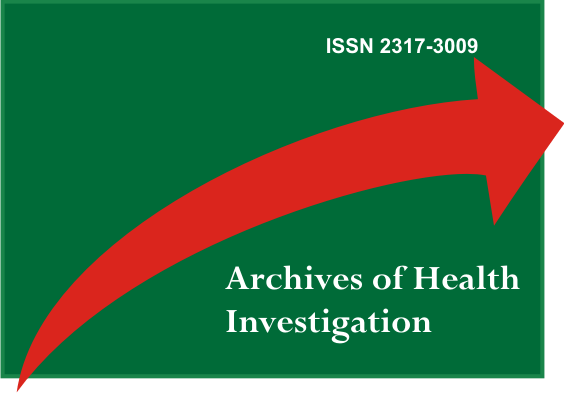Spontaneous remission of the mandibular nerve paresthesia: a case report
DOI:
https://doi.org/10.21270/archi.v7i1.2283Resumo
Introduction: Paresthesia is usually characterized by a transient loss of sensitivity in the area covered by the affected nerve. Different causes may lead to this occurrence; among them, the injury of nerve structures during the extraction of third molars. The sensitivity recovery depends on the regeneration of the nerve fibers, and in most cases it occurs spontaneously. In some situations, there is a need for a more invasive and expensive treatments to the patient. Objective: The aim of this study was to evaluate the spontaneous remission of the inferior alveolar nerve paresthesia. Case report: We studied a 34 year-old patient, white, male, which presented paresthesia of the inferior alveolar nerve after extraction of the lower right third molar. We chose to wait for the spontaneous return of the sensitivity, which occurred between the first and second postoperative month. Conclusion: The complete recovery of the sensitivity does not occur in all cases, even with the recommended treatments. So the best way to deal with paresthesia is prevention, where the dentist must perform the correct diagnosis with the aid of the necessary additional tests; besides having skill and dexterity in handling the instruments, so that the surgery would be performed safely and without any complications for the patient.Descriptors: Paresthesia; Remission, Spontaneous; Mandibular Nerve.
Downloads
Referências
Ferreira PHSG, Oliveira D, Momesso GAC, Bonardi JP, Pastori CM, Faverani LP. Enfisema subcutâneo durante exodontias de terceiro molar: relato de caso. Arch Health Invest. 2016; 5(1):33-6.
Flores JA, Flores FW, Agostini RN, Cazarolli R. Parestesia do nervo alveolar inferior após a exodontia de terceiros molares inferiores inclusos. Int J Dent. 2011; 10(4):268-73.
Vaz PNC, Albuquerque P, Oliveira AIM, Loureira IM, Moreira AMS. Abordagem da medicina chinesa na parestesia do nervo alveolar inferior pós cirurgia ortognática. Rev UIIPS. 2016; 4(3):1-7.
Flores JA, Flores FW, Unfer MK, Ferrari R. Relação entre os terceiros molares inferiores com o nervo alveolar inferior. Int J Dent. 2009; 8(4):210-4.
Devito KL, Tambúrus JR. Anatomia do canal da mandíbula. Rev APCD. 2001; 55(4):261-6.
Florian MR, Meirelles MPMR, Sousa MLR. Uso da acupuntura em um caso de parestesiados nervos alveolar inferior e lingual. Revassocpaulcirdent. 2012; 66(4):312-5.
Alves FR, Coutinho MS, Gonçalves LS. Endodontic-Related Facial Paresthesia: Systematic Review. J CanDent Assoc. 2014; 80(13):1-7.
Kaufman A. Accessing restoration margins - a multidisciplinary approach. GenDent. 2001; 49(1):58-61.
Lage LG. Paralisia facial e parestesia: condutas terapêuticas, 2003 [acesso em 12 Jul 2016]. Disponível em: http: // www.cispre.com.br.
Masur P. Cryobiology: the freezing of biological systems. Science. 1970; 168(934):939-49.
Eppley BL, Snyders RV. Microanatomic analysis of the trigeminal nerve and potential nerve graft donor sites. J OralMaxillofacSurg. 1991; 49(6):612-8.
Morse DR. Infection-related mental and inferior alveolar nerve paresthesia: literature review and presentation of two cases. J Endod. 1997; 23(7):457-60.
Rosa FM, Escobar CAB, Brusco LC. Parestesia dos nervos alveolar inferior elingual pós cirurgia de terceiros molares. RGO. 2007; 55(3):291-5.
Bataineh AB. Sensory nerve impairment following mandibular third molar surgery. J Oral Maxillofac Surg. 2001; 59(9):1012-7.
Jowet NI, Cabot B. Early warning signs of impending hypoglycaemia masked by post-extraction labial paraesthesia. Br Dent J. 1998; 185(2):70-1.
Brann CR, Brickley MR, Shepherd JP. Factors influencing nerve damage during lower third molar surgery. Br Dent J. 1999; 186:514.
Lopes GB, Freitas JB. Parestesia do nervo alveolar inferior após exodontia de terceirosmolares. ArqBras Odontol. 2013; 9(2):35-40.
Peterson L, Ellis E, Huup J, Tucker M. cirurgia oral emaxilofacial contemporânea. 3. ed. Rio de Janeiro: Guanabara Koogan; 2000. p. 267-8.
Gulicher D, Gerlach KL. Incidence, risk factors and follow-up of sensation disorders after surgical wisdom tooth removal. Studyof 1,106 cases. Mund Kiefer Gesichtschir. 2000; 4(2):99-104.
Lazaroto C, Karpstein G, Shiroma W. Tomografia computadorizada: Vantagens sobre a radiografia panorâmica na análise de terceiros molares inferiores inclusos. Revista Dens. 2007; 15(2).
Damiani GJ, Céspedes IC. Prevalência de lesão dos nervosalveolar inferior, bucal e lingual emprocedimentos operatórios. Rev Odonto. 2007; 15(29):50-7.


